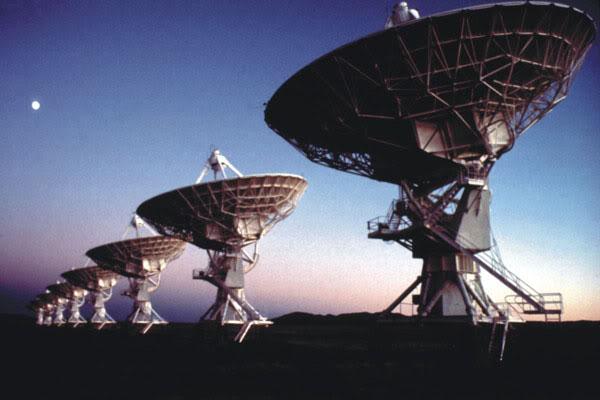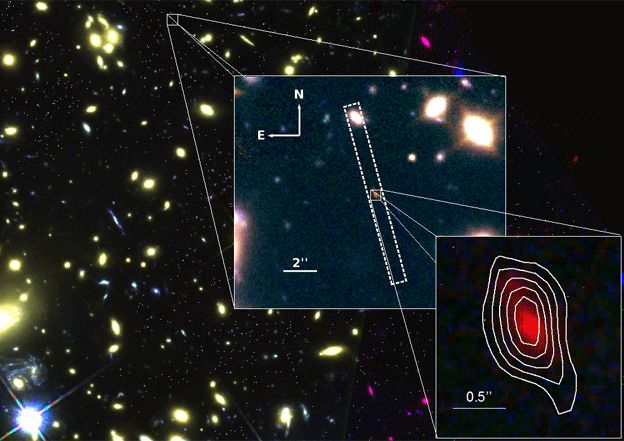
Astronomers have made the most distant ever detection of oxygen.
They observed it in a galaxy of stars that existed just 500 million years after the Big Bang.
But what is really fascinating is that this oxygen can only have been produced in an even older group of stars that would have dispersed it when they died and blew themselves apart.
That means we could be witnessing the traces of events that occurred a mere 250 million years after the Big Bang.
Scientists reporting in the journal Nature say this takes us back into the theorised epoch known as Cosmic Dawn when the Universe was first bathed in light.
The team cannot see this critical period directly – it is beyond the capability of current technology. But it augurs well for future telescopes that will be tuned to see the dawn – namely, the James Webb space observatory, which is due for launch in 2020.
This mission, the successor to Hubble, will carry an immense mirror and instruments that are designed specifically to detect the glow coming from the very first population of stars.
The distance to the reported galaxy – called MACS1149-JD1 – was confirmed with the Atacama Large Millimetre/Submillimetre Array (Alma), and the European Southern Observatory’s Very Large Telescope (VLT).
These facilities studied spectral lines from hydrogen – in the case of the VLT – and from oxygen – in the case of Alma.
They found both these emissions to have been shifted to longer wavelengths by the expansion of the Universe.
“The horizon for this particular object is what we call a Redshift 9.1,” explained Richard Ellis, a professor of astrophysics at University College London, UK.
“That means the Universe has expanded nine to 10 times since the light left this object. We’re looking back about 97% of the way to the Big Bang (13.8 billion years ago) when the Universe was only about 500 million years old.
“But we have a clever trick that tells us how old the stars are already at that time in this galaxy. That gives us an indication of how much earlier in the history of the Universe – which we can’t currently probe with our telescopes – that this object actually formed. And we find this galaxy formed its stars when the Universe was only 250 million years old, which is like 2% of the present age of the Universe.”

The Big Bang produced a cosmos that was filled with hydrogen, helium, and a small amount of lithium.
All the elements heavier than these three had to be forged inside stars through the process of nuclear fusion.
The calcium in our bones, the phosphorous in our DNA and the iron in our blood comes from successive generations of stars that seeded the cosmic environment when they went supernova and exploded at the end of their lives.
The oxygen in MACS1149-JD1 by definition therefore has to reach back to a time earlier than it is being seen.
There is a growing body of evidence now suggesting that the first stars began to ignite around perhaps 200 million years after the Big Bang, so this puts the progenitors of this oxygen there or thereabouts.
“We don’t think Cosmic Dawn is a sudden event; it would be dramatic if it was; I would love to have been there,” said Prof Ellis. “We think it was a gradual event and so clearly it is going to take statistics to work out exactly when it happened. We have found one object, but we have now found two other objects with a similar tell-tale signature of old stars. Sadly, we don’t yet have the clinching redshifts for these objects.”
That is a job for the VLT and Alma again, although astronomers have to be patient and wait their turn to use these facilities, especially Alma. This super-scope of 66 radio dishes positioned high up in Chile’s Atacama desert opened in 2011, and is now in very high demand.

The team is not quite finished with MACS1149-JD1. One question the scientists would like to answer is whether this galaxy has a super-massive black hole at its core. All the large galaxies we see in the nearby Universe have these central giants that are millions of times the mass of our Sun; and it is an interesting debate as to how early this phenomenon emerged in cosmic history.
“If we could demonstrate there is a black hole here that would be amazing,” commented UCL team-member Dr Nicolas Laporte.
“You could map the distribution of oxygen with Alma and in the case of a black hole – because you have a high radiation field associated with the black hole – then this oxygen should be very compact. Whereas in the case of no black hole, then the oxygen would be more dispersed,” he told BBC News.
The Nature paper published this week is a joint effort between UCL and Osaka Sangyo University in Japan. Dr Takuya Hashimoto and Prof Akio Inoue led the Osaka Sangyo side.
